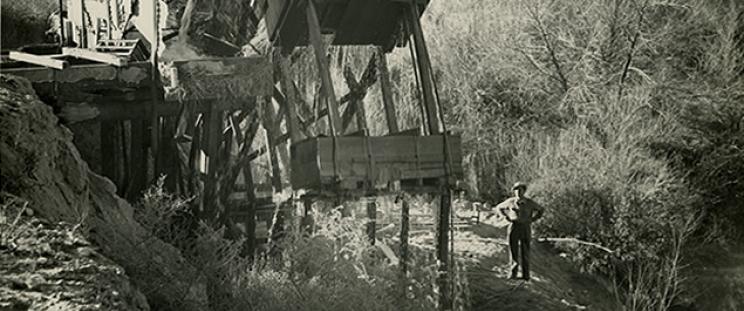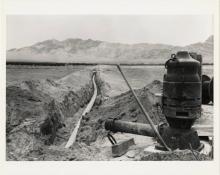Collection Paragraphs

“ A vast area of the arid lands will ultimately be reclaimed and millions of men, women and children will find happy, rural homes in the sunny lands . . .”
John Wesley Powell, Report on the Lands of the Arid Region of the United States, 1878
“Emancipation”
Inquiry:
Would the tone of this poem change if written by: a.) Native Americans of the era or b.) Walter Bracken?
The Nation reaches its hand into the Desert
And lo! Private monopoly in water and in land is scourged
From that holiest of temples, -- the place where men
Labor and build their homes!The Nation reaches its hand into the Desert
The wasting floods stand back, the streams obey their
Master, and the stricken forests spring to life again
Upon the forsaken mountains!The Nation reaches its hand into the Desert
The barred doors of the sleeping empire are flung wide
Open to the eager and the willing, that they may
Enter in and claim their heritage!The Nation reaches its hand into the Desert
That which lay beyond the Grasp of the Individual yields
To the hand of Associated Man. Great is the
Achievement, -- greater the Prophesy!William E. Smythe, The Conquest of Arid America, 1899
“Clark buys ‘Oasis in the Desert: The famous Las Vegas Ranch'; tropical fruits, dates, figs etc. and the citrus fruits can be produced in a way to rival the most favored sections of southern California.”
Deseret News, October 18, 1902, reporting Senator Clark’s purchase of Helen Stewart’s ranch
Inquiry:
This prospectus invites investors to contribute funds to facilitate drilling artesian wells. Given only what was known about the Las Vegas Valley in 1905, would this appear to be a good investment choice?
“This is a home organization, we are all interested in the development of the Vegas valley and we solicit the aid, on an equal footing with us, of every person interested in the general prosperity of Las Vegas and the agricultural lands surrounding. We have many thousands of acres rich enough for farming, and level enough for irrigation. We have no known water supply. We believe that artesian water may be had in abundance. And by the following plan proposed we will acquire land and bore artesian wells, and each contributing will receive his share of the profits of our operations. We want all to subscribe to our stock . . . “
Vegas Artesian Water Syndicate, prospectus, incorporated November 1905
“Las Vegas, Nevada, where farming pays : the artesian belt of semi-tropic Nevada"
Las Vegas Chamber of Commerce, promotional brochure, 1912
Inquiry:
What motivation might the Las Vegas Chamber of Commerce of 1914 have had to encourage "the landless man" to relocate to the town?
SEMI-TROPICAL NEVADA: A Region of Fertile Soils and Flowing Wells. This Booklet is dedicated to the landless man who is seeking cheap lands which may be made valuable by small capital and his own labor.
Las Vegas Chamber of Commerce, promotional brochure, 1914
The great military and scientific surveys of the American West conducted by the U.S. government in the 19th century were directed ultimately toward the future settlement and exploitation of the West. Associated with the expeditions to survey and map a route for the transcontinental railroads were later geological and topographical studies to explore the feasibility of irrigation to support agriculture. Irrigating the desert by controlling and diverting entire river systems was a manifestation of American engineering destiny. The monument of this remains Hoover Dam, constructed—miles from the small town of Las Vegas—essentially to provide water and power for California and Arizona.

Ranching and agriculture in Southern Nevada depended upon irrigation, tapping and re-directing the natural springs and waterways into a patchwork of sluices and ditches. The region's rivers and streams, including the Las Vegas Creek, sustained localized agriculture, orchards, and even viniculture, and provided grass for cattle and stock. Farmers along the Colorado River used water wheels to raise irrigation water, and for a time the Moapa Valley exported rail cars of melons, asparagus, and other agricultural goods. Farmers still grow wheat and alfalfa in the Virgin River Valley with diverted river water, and farmers in the Amargosa Valley currently use center pivot irrigation for their crops.
Inquiry:
Contemporary aerial views of Southern Nevada would be unlikely to inspire those with agricultural interests. What differences as evidenced in aerial views from the late 19th and early 20th centuries suggested prime agricultural resources in Las Vegas and its surrounding valleys?
The perceived potential for irrigation to turn the Las Vegas Valley into a rich agricultural region became a theme for promoters and developers, as well as the city’s own Chamber of Commerce. But the Las Vegas Valley was not to become the new Southern California, as water was diverted increasingly to domestic and industrial use. The old Stewart Ranch would continue to operate as a dairy and cattle ranch under a variety of tenants, and the railroad would even contemplate creating a Model Farm there. But the Stewart Ranch was eventually swallowed up by the sprawling city. Ironically, the people of Las Vegas viewed Lake Mead not as a source of domestic water but for irrigation.
